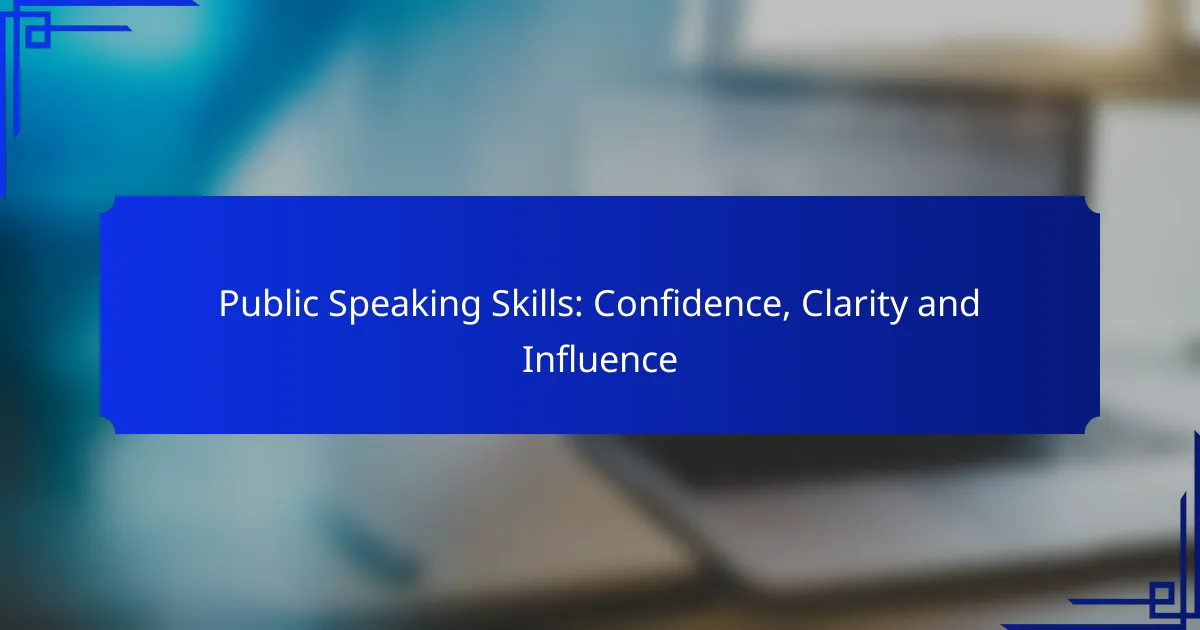Public speaking is a vital skill that encompasses confidence, clarity, and influence. By practicing consistently and adopting a positive mindset, you can build the self-assurance needed to communicate effectively. Utilizing structured messaging and engaging narratives enhances clarity, while establishing credibility and emotional connections boosts your influence as a speaker.
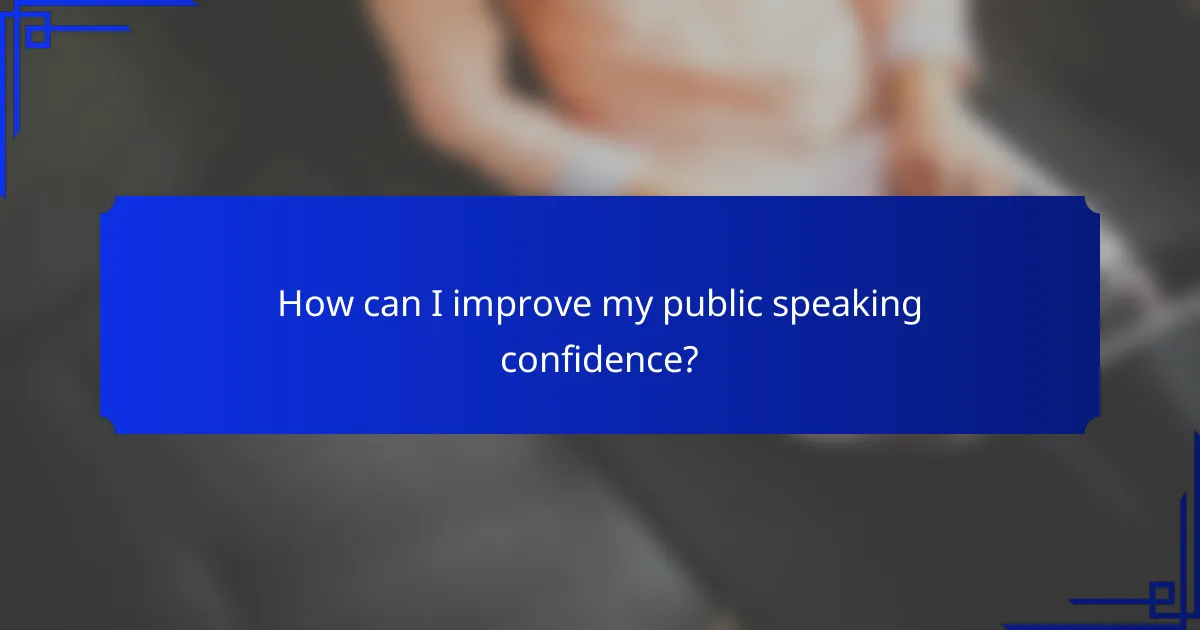
How can I improve my public speaking confidence?
Improving public speaking confidence involves consistent practice, positive mindset techniques, and real-world experience. By actively engaging in these strategies, you can build your self-assurance and enhance your ability to communicate effectively.
Practice with Toastmasters
Joining a Toastmasters club is a practical way to enhance your public speaking confidence. These clubs provide a supportive environment where members practice speeches and receive constructive feedback. Regular participation can help you become more comfortable speaking in front of others.
Toastmasters meetings typically involve prepared speeches, impromptu speaking, and evaluations, allowing you to develop various skills. Aim to attend meetings consistently, as frequent practice can lead to noticeable improvements over time.
Use positive visualization techniques
Positive visualization can significantly boost your confidence before a speaking engagement. This technique involves imagining yourself successfully delivering your speech, engaging the audience, and receiving positive reactions. Visualizing success can help reduce anxiety and reinforce a confident mindset.
To practice visualization, find a quiet space, close your eyes, and picture yourself on stage. Focus on the details: the audience’s smiles, your clear voice, and your relaxed body language. Doing this regularly can create a mental blueprint for success.
Engage in mock presentations
Mock presentations are an effective way to simulate the public speaking experience and build confidence. Gather friends or family to act as your audience and present your material as if you were in a real setting. This practice can help you refine your delivery and receive valuable feedback.
Consider recording your mock presentations to review your performance later. Pay attention to your pacing, body language, and clarity. Aim to conduct these sessions regularly, gradually increasing the complexity of your topics as you become more comfortable.
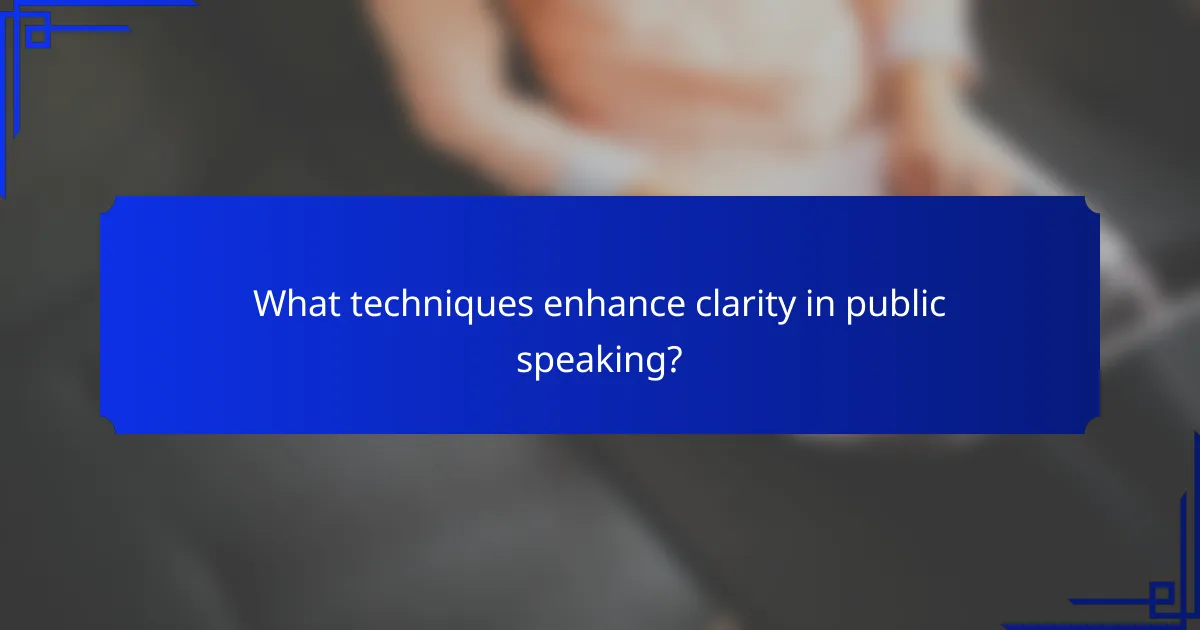
What techniques enhance clarity in public speaking?
To enhance clarity in public speaking, techniques such as structured messaging, engaging narratives, and effective visual aids are essential. These methods help ensure that your audience understands your message and remains engaged throughout your presentation.
Utilize the Pyramid Principle
The Pyramid Principle is a communication technique that organizes information in a logical structure, starting with the main idea followed by supporting details. This approach helps the audience grasp the core message quickly and understand how the supporting points relate to it.
When applying this principle, begin with a clear statement of your main point, then break it down into key arguments or evidence. This structure allows listeners to follow your thought process easily, making your message more memorable.
Incorporate storytelling methods
Storytelling is a powerful tool in public speaking that can make complex ideas more relatable and engaging. By weaving personal anecdotes or relevant narratives into your presentation, you can create an emotional connection with your audience, enhancing their understanding and retention of the material.
To effectively incorporate storytelling, choose stories that align with your message and resonate with your audience’s experiences. Aim for brevity and clarity to maintain focus and avoid losing your audience’s attention.
Employ clear visual aids
Clear visual aids, such as slides, charts, or infographics, can significantly enhance the clarity of your presentation. They serve to illustrate key points and make complex information more digestible, allowing your audience to visualize the concepts being discussed.
When creating visual aids, prioritize simplicity and relevance. Use large fonts, contrasting colors, and minimal text to ensure readability. Avoid cluttering slides with excessive information, as this can overwhelm your audience and detract from your spoken message.
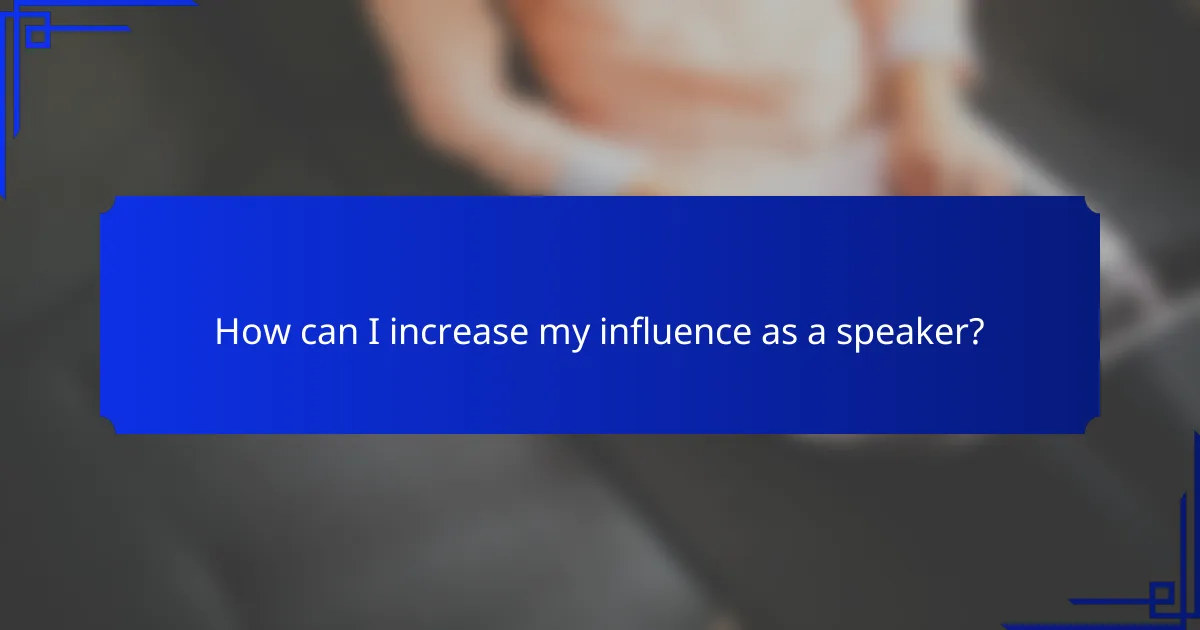
How can I increase my influence as a speaker?
To increase your influence as a speaker, focus on establishing credibility, connecting emotionally with your audience, and using persuasive language. These elements work together to enhance your message and engage listeners effectively.
Establish credibility through expertise
Credibility is crucial for influencing your audience. Demonstrating expertise in your subject matter can be achieved by sharing relevant experiences, qualifications, or research. For example, if you are discussing financial planning, mentioning your background in finance or citing reputable studies can enhance your authority.
Consider using anecdotes or case studies that showcase your knowledge. This not only builds trust but also makes your content relatable. Avoid overloading your audience with jargon; instead, explain complex concepts in simple terms to maintain engagement.
Connect emotionally with the audience
Emotional connection can significantly enhance your influence as a speaker. Use storytelling to evoke feelings and create a bond with your audience. Personal stories or relatable scenarios can make your message more impactful and memorable.
Pay attention to your audience’s reactions and adjust your delivery accordingly. Engaging with them through questions or interactive elements can foster a sense of involvement. Remember, an emotionally engaged audience is more likely to be influenced by your message.
Use persuasive language and techniques
Persuasive language is key to influencing your audience effectively. Utilize rhetorical devices such as metaphors, repetition, and questions to emphasize your points. For instance, starting with a thought-provoking question can capture attention and encourage reflection.
Incorporate techniques like the rule of three, which suggests that ideas presented in groups of three are more memorable. Additionally, be mindful of your tone and body language; confident delivery can enhance the persuasive power of your words. Avoid filler phrases that dilute your message and focus on clarity and conviction.

What are the prerequisites for effective public speaking?
Effective public speaking requires a solid foundation in understanding your audience and thorough research of your topic. These prerequisites help ensure that your message resonates and engages listeners, making your delivery more impactful.
Understanding your audience
To connect with your audience, you must first understand their demographics, interests, and expectations. Consider factors such as age, profession, cultural background, and knowledge level about the topic. Tailoring your message to fit these aspects can significantly enhance engagement.
Engagement strategies include asking rhetorical questions, using relatable anecdotes, or incorporating humor that aligns with the audience’s preferences. For instance, a presentation aimed at young professionals may benefit from contemporary examples and a casual tone, while a corporate audience might require a more formal approach.
Researching the topic thoroughly
Thorough research on your topic is crucial for establishing credibility and confidence during your presentation. This involves gathering information from reliable sources, understanding various viewpoints, and being prepared to answer potential questions. Aim to cover the key aspects of your topic comprehensively.
Utilize a mix of academic articles, books, and reputable online resources to build a well-rounded perspective. Create an outline to organize your findings, and consider practicing your delivery to ensure clarity and fluency. Avoid common pitfalls such as overloading your audience with jargon or excessive details that may confuse rather than inform.
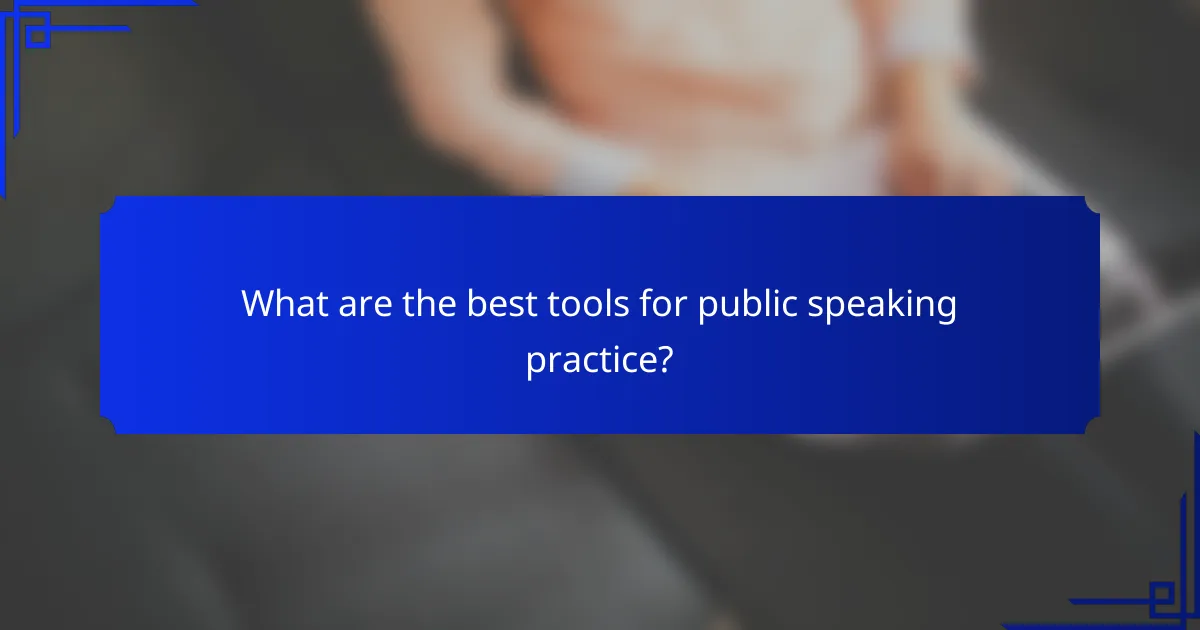
What are the best tools for public speaking practice?
The best tools for public speaking practice include advanced Speech Coach AI platforms and video recording techniques. These resources help speakers enhance their confidence, clarity, and overall influence during presentations.
Speech Coach AI platforms
Speech Coach AI platforms utilize artificial intelligence to provide real-time feedback on various aspects of your speaking performance. These tools analyze voice modulation, pacing, and clarity, offering personalized tips for improvement.
Popular platforms often include features like speech analysis, practice prompts, and even virtual audiences to simulate real-life scenarios. Consider options that offer a user-friendly interface and compatibility with various devices.
Video recording for self-review
Recording your speeches on video is a straightforward yet effective method for self-review. This approach allows you to observe your body language, facial expressions, and overall delivery, which are crucial for engaging your audience.
When reviewing your recordings, focus on specific elements such as eye contact, gestures, and vocal variety. Aim to record multiple practice sessions to track your progress over time and identify areas for improvement.
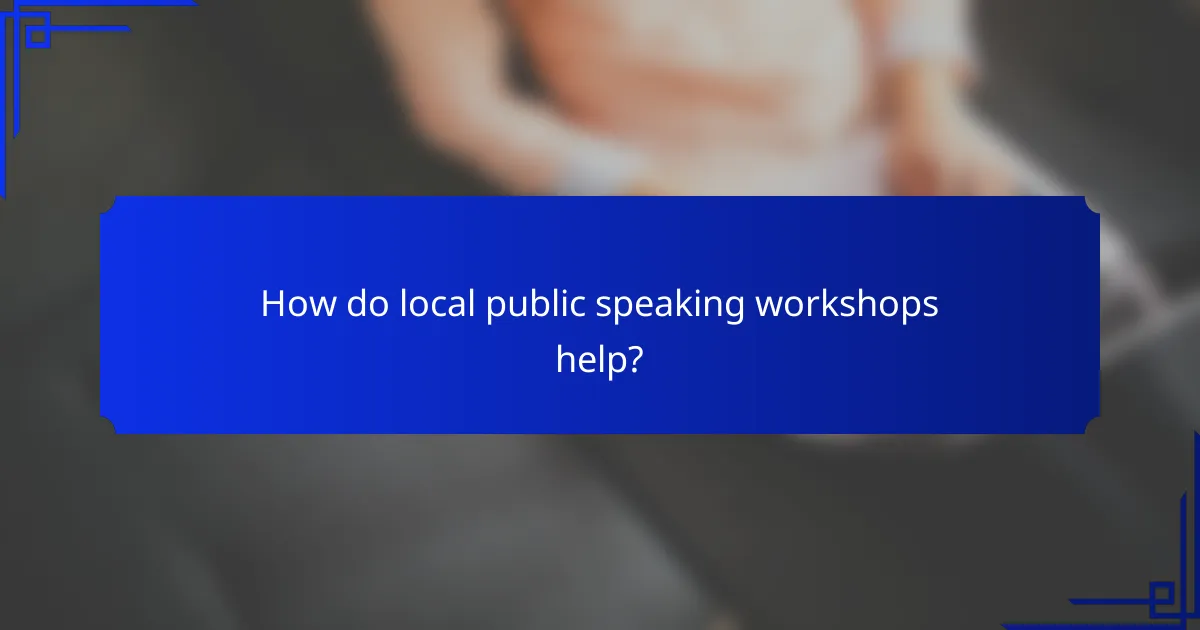
How do local public speaking workshops help?
Local public speaking workshops enhance skills by providing structured environments for practice and feedback. Participants gain confidence, clarity, and influence through hands-on exercises and expert guidance tailored to their specific needs.
Networking opportunities in Los Angeles
Networking opportunities in Los Angeles are abundant within public speaking workshops. These events attract diverse professionals, allowing participants to connect with peers, industry leaders, and potential collaborators.
Attendees can exchange ideas, share experiences, and build relationships that may lead to future speaking engagements or career advancements. Workshops often include informal networking sessions, enhancing the chances of making valuable connections.
To maximize networking, consider following up with contacts after the workshop via email or social media. This can help solidify relationships and open doors for future opportunities in the vibrant Los Angeles professional scene.
